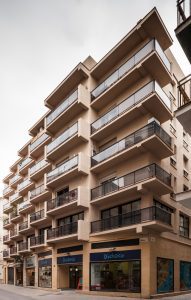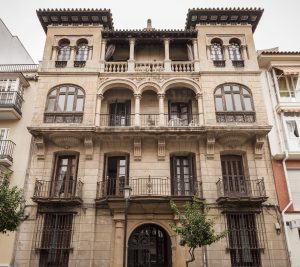
Edificio Lazcano, 8
Edificio Lazcano 8 dates back to 1966 and was built as part of the urban development that took place in the second half of the 20th century in Malaga.

Marqués de Larios, 3 was built around 1888-1889. This 19th century bourgeois style building was designed by architect Eduardo Strachan Viana-Cárdenas, who introduced Chicago school style architecture to the city of Malaga, but with the European feel of Haussmann’s Parisian boulevards.
Other notable designs by this architect include the pantheon of the Larios family, the Álvarez Fonseca department store, the psychiatric ward of the Civil Hospital; and numerous villas in the area of La Caleta, as well as the initial project for the Malaga park commissioned by Antonio Cánovas del Castillo, president of Spain’s Council of Ministers for most of the last quarter of the 19th Century.
Its construction is in harmony with the other buildings on this street, designed by the same architect. It faces three streets: Calle Moreno Monroy to the north, Calle Salinas to the southeast, and Calle Marqués de Larios to the west. This trapezoid shaped building with interior courtyards is spread over five storeys including the ground floor. It is a Grade 1 listed building within the historic-artistic BIC (Bien de Interés Cultural) protected heritage area of Málaga.
The building façade on the ground and first floors has ledges separated by fluted pilasters, creating a harmonious appearance. On the upper floors, the building can be divided into a central body flanked by symmetrical sides. The sides are adorned with exposed brick facing and bartizans. The second-floor balconies are divided into triples and single balconies on the bartizan. Those on the third floor are all single but retain the decorative model of the lower level, consisting of carved posts and lintels topped by a straight cornice mounted on brackets (a model that is repeated in the other buildings along Calle Marqués de Larios).
These floors are defined horizontally with imposts, but a cornice supported on slim corbels demarcates the windows of the top floor that features a cornice supported by larger corbels. The upper floor on the right side of the building is more highly decorated with ionic pilasters that frame its window openings. The bartizans are linked vertically with pilasters. The sides of the building maintain the height and decoration of these sections, although they are adorned with stucco, contrasting with the exposed brickwork. In C/ Moreno Monroy, there are five sets of window openings, alternating the ledges with three balconies. The central balconies have wooden shutters. The building façade facing Calle Salinas continues along this line with stucco plasterwork along the bottom, and seven columns of balconies and alternating ledges.
The central section of Marqués de Larios, 3 is lower in height as it lacks the top floor. In this section, which features stucco plaster work, there are two floors separated by imposts with seven columns of architrave balconies decorated with carved posts, lintel with symmetrical floral decoration crowned with a curved cornice. The impression of verticality created by the building is highlighted through the addition of wooden shutters on the second and sixth vertical sections of the façade, and by the central section that stands proud of the rest of the building. This section also features a horizontal cornice with egg and dart mouldings. The appearance of symmetry has been created through ornamentation, the use of different heights, and decorations on the window openings of the central and side sections.
The main entrance has large solid wood doors and bronze knockers framed by a stonework portico, leading into a hallway with white marbled flooring and the image of the company that owns the building in dark green. In this entrance we find a lift for people with reduced mobility, as well as a magnificent white marble elliptical staircase with wrought iron and wooden banisters. There is a secondary entrance on Calle Moreno Monroy.

Edificio Lazcano 8 dates back to 1966 and was built as part of the urban development that took place in the second half of the 20th century in Malaga.

Edificio Guillén de Castro, 2 dates from 1875, with an eclectic style typical of Malaga architecture in the 19th century.

Edificio Calle Victoria, 38 was built around the year 1927. Built in the neo-Mudejar historicist style, this building was designed by architect Fernando Guerrero Strachan.